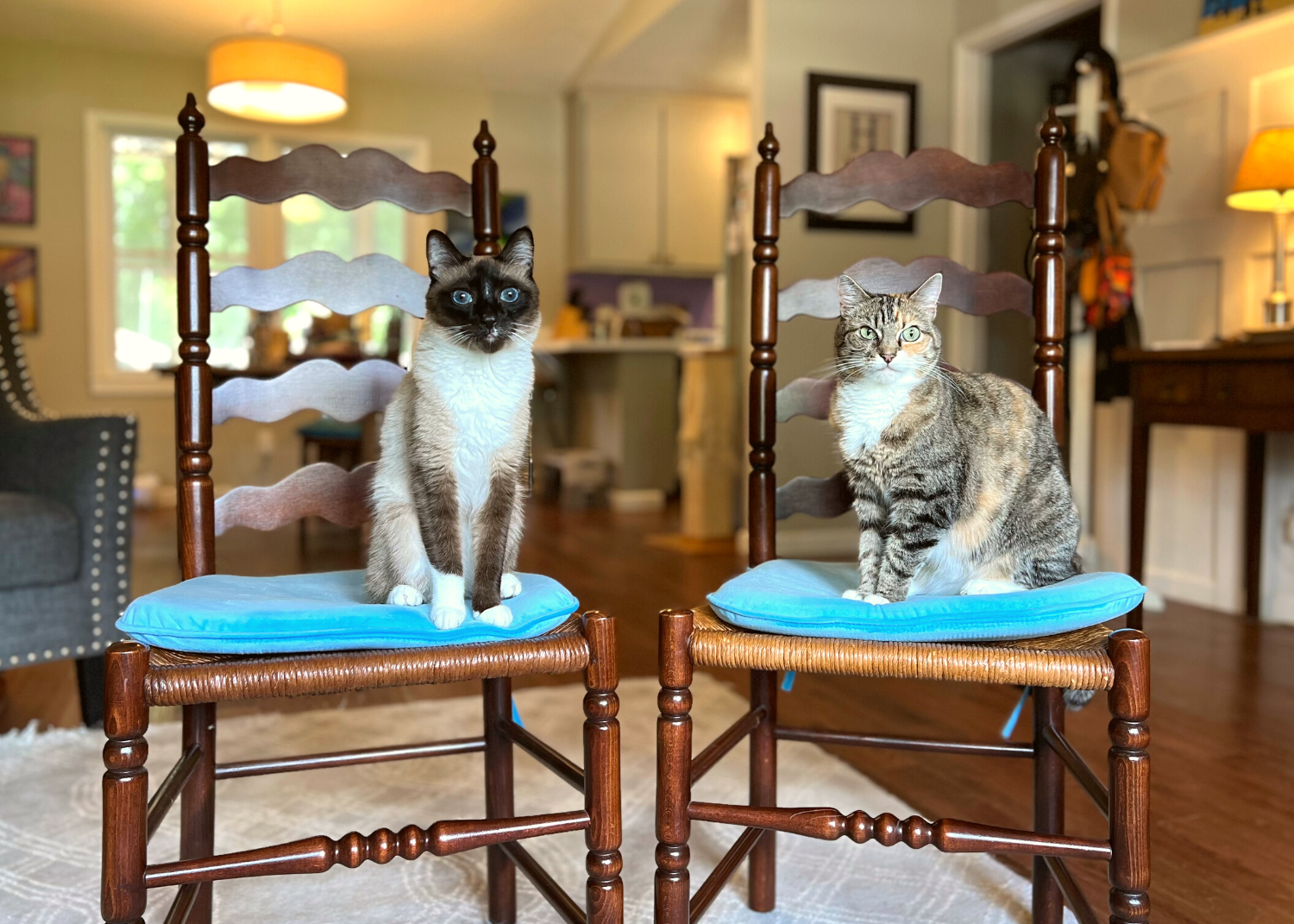Clicker Training Two Cats Together (or even more!)
Updated: June 6, 2024
If you are starting your cat training journey, you are probably wondering the best approach to clicker training multiple cats. Is it better to train them separately, or should you train them together? While either option works, there are benefits (and obstacles) to both. Keep reading for tips to make the process easier!
Disclosure: Cat School may receive commissions from affiliate links included in this article.
Separating Your Cats
Trying to teach one cat can be challenging enough, but when you start to add more cats into your “classroom” it can get chaotic, especially if all your cats are eager to participate.
When you start working with your cats, I recommend separating them (if possible). This will allow you to give each cat the time and patience they need to learn the rules of training.
If you have a home with natural separations, like rooms, try to separate your cat by working in a room with one cat at a time. However, if separating your cats causes them lots of stress (for example, one cat is scratching at the door or vocalizing, and the other cat is getting distracted), you will need to explore other options (more on this down below).
Even if you have goals of training your cats together, it’s much easier to teach a few foundational skills to each cat independently before training them together. Learning these foundational behaviors will help them to be good classmates.
Foundational behaviors include:
- following a finger target
- sit at their place (“parking spot” training)
- stay
Once your cat has mastered these skills independently, you can begin what I call the “Students in a Classroom” setup for training multiple cats together!
As a side note, I encourage everyone with very bonded cats to help their cats learn to be independent. We don’t want our cats to panic when they are separated but to be well-adjusted to independent time and time spent away from other cats working with you.
A good starting point to encouraging this separation is with meal times. Pairing feeding times with separation can help each cat see that separation is good because it equals getting fed.
Easy Ways to Introduce Training with Two Cats Together – Like Children in a Classroom
If you aren’t able to separate your cats for training, or you want to be able to train two cats together, you can follow the steps outlined below. This training plan will set you and your cats up for success to be able to train like children in a classroom!
Start with food puzzles or snuffle mats
Step 1: Give each cat a food puzzle to work on. You can start by doing this in the same room and placing yourself between your cats, each on either side of you. The goal is for each cat to stay at their own station and focus on their puzzle instead of on what the other cat is doing.
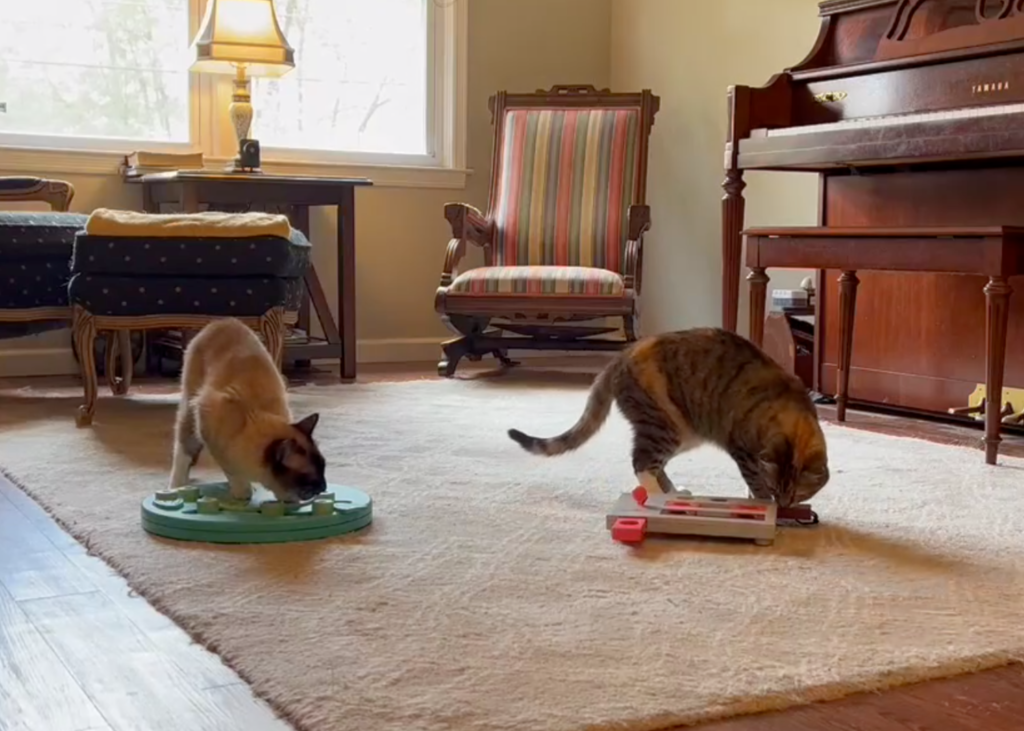
Step 2: Use the clicker to reinforce each cat’s attention. When one cat looks up, click and give them another treat at their station. The goal is for each cat to look at you when they finish their puzzle to get more treats instead of going over to the other cat’s puzzle.
Step 3: Encourage your cat to move away from their food puzzle (“seat”) and then back to their “seat,” while the other cat stays at their “seat.” A similar analogy is like when a student in a classroom goes up to the front of the class and then goes back to their seat without stopping to visit with other students along the way.
To achieve this, you can give a treat to the cat who will be staying at their seat to reinforce their stay. Simultaneously, you’ll toss a treat away for the other cat, and then reward with another treat when they return back to their “seat” (like the ping pong kitty game). The other cat will continue to get treats for being good and staying at their “seat.”
Repeat this step so each cat gets a turn at this exercise going in opposite directions. Sitting in between your cats is an excellent way to increase their success and reinforce them for returning to their spots.
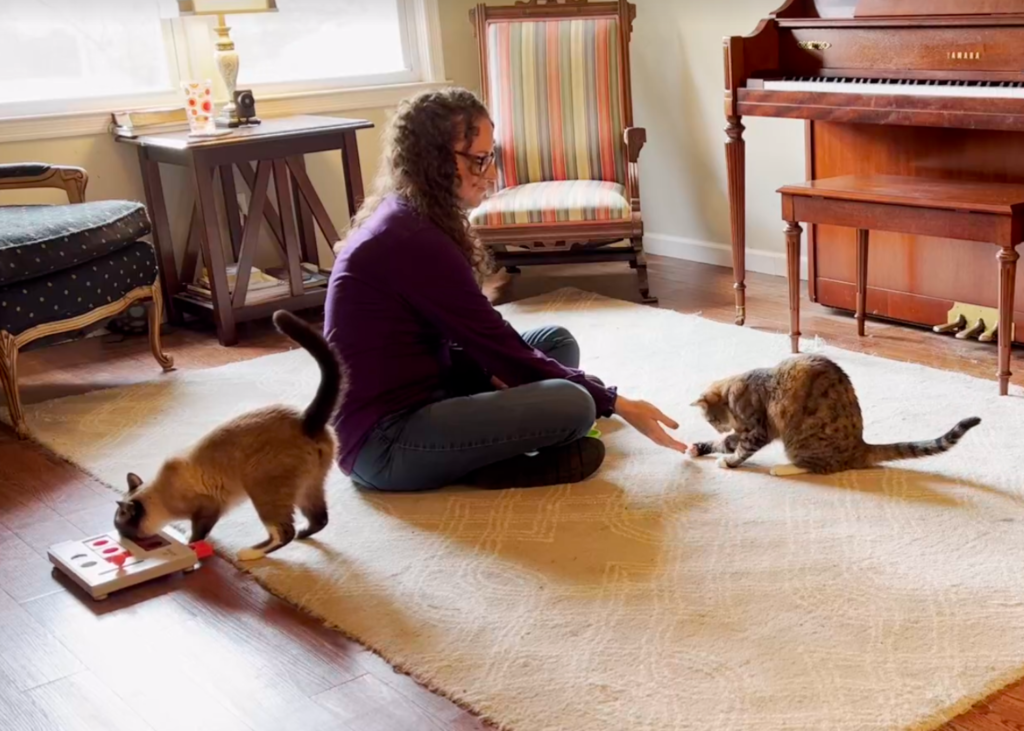
Troubleshooting: If one cat tries to get to the other cat’s food puzzle, click as soon as they look up and put a special treat in their puzzle to entice them back to it. You can also sit between them or use a doorway/gate to create a barrier.
Sit at a doorway
A doorway can be a great barrier. Sit at the doorway (with the door slightly open) and use treats to try to encourage each cat to stay at their respective sides. You know this training works when the cats start waiting for you to give them another treat instead of trying to get past the door to see their “classmate.”
Introduce the ping-pong kitty game and start tossing treats further away for the cats to search for them. When one cat is searching for a treat, try teaching the other cat simple basics like sit.
Move to an elevated surface
Now it’s time to move your cats to more defined “seats.” I recommend using feline cots for this training.
Step 1: Teach your cat to get onto their cot. An easy way to get started is to layer the snuffle mat or food puzzle over the cot. You can also use a target stick or finger target to teach this behavior. The goal is to encourage your cat to go to their bed to eat their treats on their mat.
If you don’t have cots, you can use chairs. Just be sure they are comfortable and not slippery.
Step 2: Introduce stay training. Reward your cat for staying at their seat, even when you walk towards the other cat. The goal is for one cat to stay at their seat while you approach the other cat.
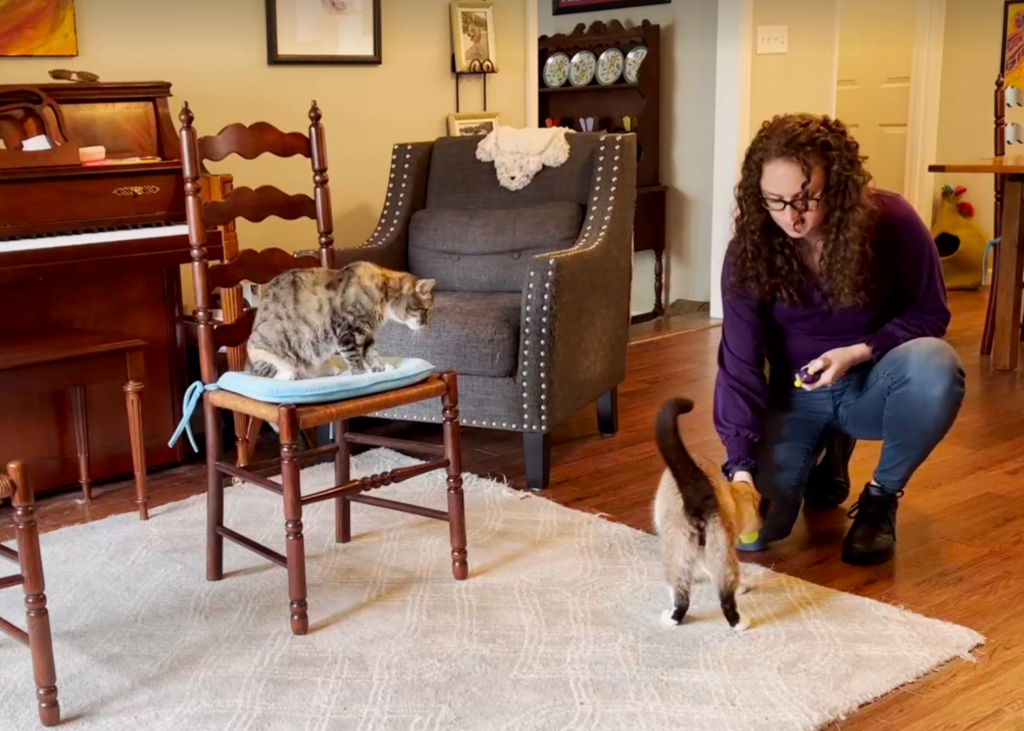
Step 3: Start introducing training skills to your cats. The goal is for one cat to work on a skill while the other cat gets reinforced for staying at their seat. You can also have one cat engaged with a food puzzle while you work with the other cat. Figure out which set up works best for you and your cats.
If your cat leaves their spot when they aren’t supposed to, that means they need more reinforcement with the previous steps or your need to do shorter sessions with each cat for now.
Troubleshooting:
- If your cats keeping trying to go over to the other cat’s station, consider sitting or standing between them or use a doorway as a barrier to keep them on their respective sides.
- If these methods are really failing and things are chaotic, consider getting a playpen or gate to help with managing both cats until they learn the class rules. Playpens can be an excellent way to keep your classroom a little less chaotic while keeping all your students happy because even though they are confined they get to be part of the action.
Multi-Cat Training FAQs
What if I have more than two cats?
If you have more than two cats, you can continue with the parking spot method by training each cat to stay in their seat. Two cats would stay at their seat while the other gets a turn.
You can try putting all except the cat you plan to train with in a room behind a closed door. You can add some enrichment to the multi-cat room (like puzzles or toys) so they barely even notice that one cat is missing. This will allow you to train independently with one cat at a time.
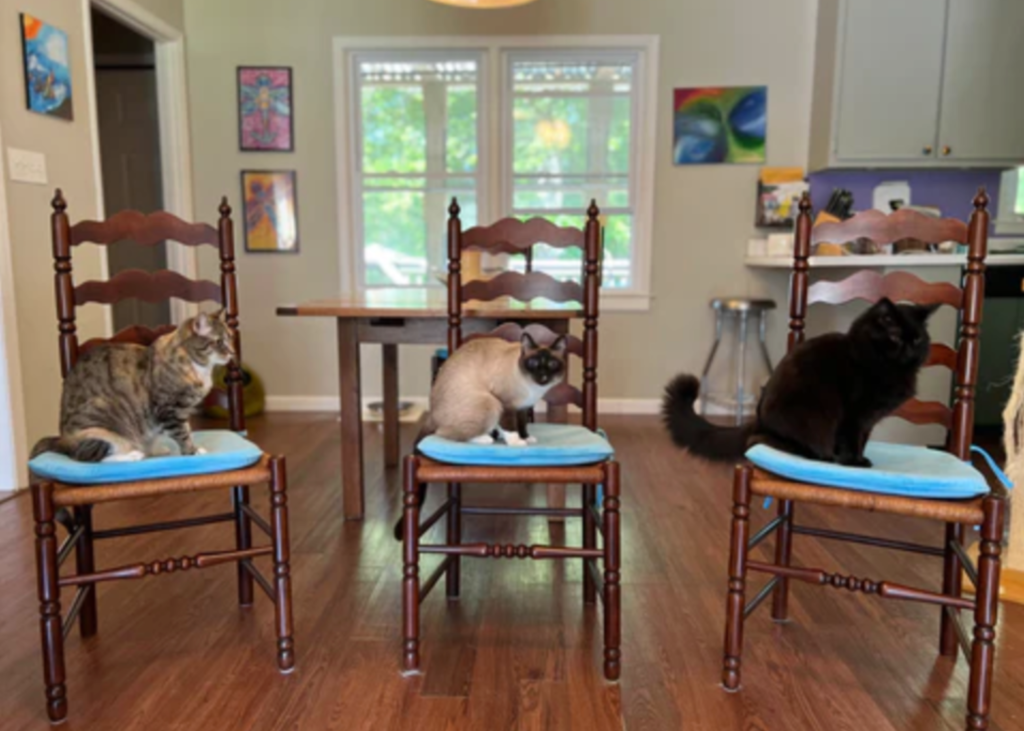
Will this training help cats who don’t get along?
Teaching your cats to stay at their seats is a great way to support introductions and improve cat-cat introductions. I highly recommend reaching out to a cat behaviorist to get some support in using clicker training as a tool to improve your cat’s interactions.
Does a cat get confused when they hear the click and it’s not their turn?
Cats are really good at understanding our attention and interactions. This means that when you’re working with one cat, it’s going to be pretty obvious to the other that it’s not their turn. You’ll have your back to them and you won’t be asking them to do anything.
That being said, when first getting started, I like to use a very high rate of a reinforcement with the cat that’s waiting for their turn. You almost always give them a treat anytime you click, so when you’re working with one cat and they do something correctly, you click and treat both cats. That way one is rewarded for their work while the other is simultaneously reinforced to stay at their place.
You can gradually decrease the rate of reinforcement just so that it’s stable, the cat understands to stay at their place, and they get reinforced every so often.
VIDEO: How to Train Two (or more) Cats Together
Whether you’re clicker training two cats or clicker training multiple cats, it can be a bit to juggle, but the end results will be well worth the effort! If you run into any trouble with your training, Cat School Teacher Julie Posluns would love to help you out. By joining Cat School, you’ll have access to our course on training multiple cats, as well as access to Julie to be able to ask her any questions or get personalized feedback on your training.

